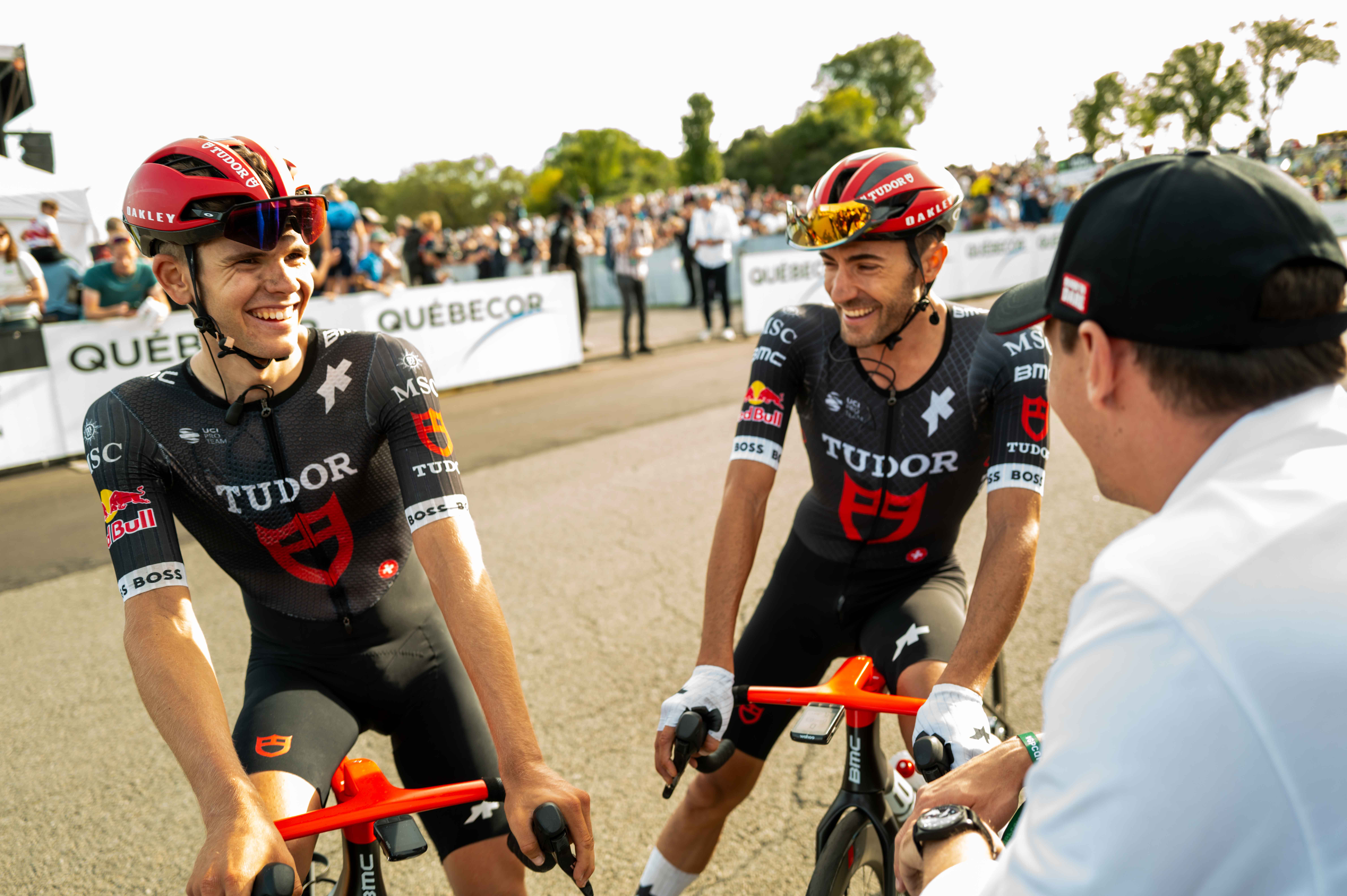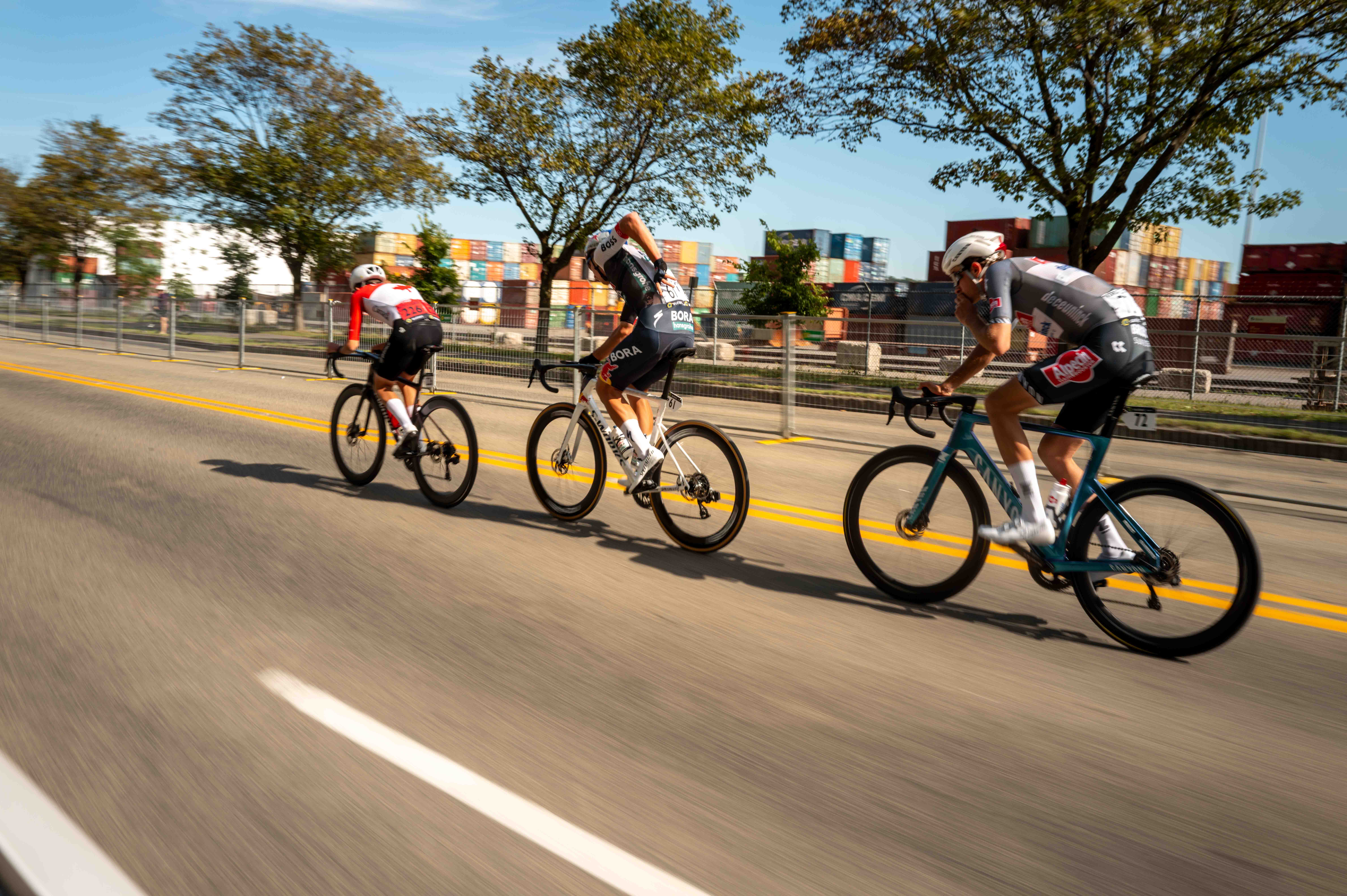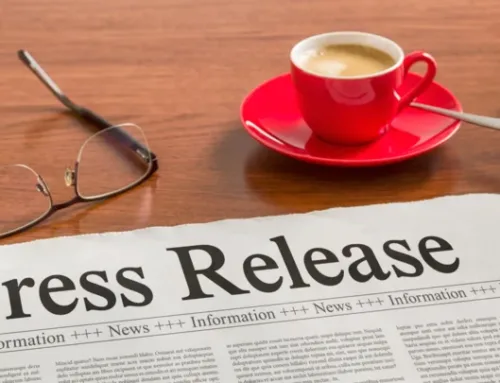Tudor Is Investing Heavily In Cycling—And It’s Working
October 31, 2025
Julian Alaphilippe was sitting by himself, quietly working through a mountain of perfectly placed carbohydrates when I arrived. I had just landed in Québec City and was still trying to get my bearings when I spotted him across the lobby of the team hotel, the undeniable star of French cycling, two-time World Champion, the winner of six Tour de France stages, and the marquee signing for Tudor Pro Cycling this year. I shook his hand, introduced myself, and walked away, wondering if that really was the same guy I’d watched effortlessly dance on the pedals while riding some of the steepest climbs in France during countless Tours de France—now tucked into pasta and chicken ahead of tomorrow’s Grand Prix Cycliste de Québec, the biggest one-day cycling race in North America. Sure enough, it was. And as I would soon find out, I’d be seeing a lot more of him over the weekend.
Julian Alaphillipe ahead of the Grand Prix Cycliste de Québec. Photo courtesy of Tudor/James Startt.
I was in Canada to understand why Tudor—a brand known for diving watches and steel sports icons—has poured itself into professional cycling, a sport not exactly known for minting commercial windfalls. When the watchmaker joined a sponsorship landscape dominated by telecoms, supermarkets, and bike manufacturers, the move raised questions. It turns out, watches and cycling have far more in common than meets the eye.
Tudor’s strategy becomes increasingly clear when you zoom out. Cycling isn’t yet a marquee sport in North America (ironically, now the world’s largest market for luxury watches). Still, it is a major global spectacle with heroes who command massive followings across Europe and beyond. Riders like Tadej Pogačar of Slovenia and Dutch superstar Mathieu van der Poel are helping push the sport into mainstream consciousness, and doing so with six-figure watches on their wrists (some even worn during competition). As the sport continues to broaden its reach, it feels like only a matter of time before more watch brands enter the conversation. Tudor and its Pro Cycling Team may simply be early and very well positioned, with enormous upside ahead.
Tudor Pro Cycling launched just four years ago in the sport’s fourth division. Since then, the team has earned roughly one promotion per season—a Welcome-to-Wrexham-like ascent that now has them in the World Tour, including a debut in this summer’s Tour de France. The approach has been methodical. Tudor didn’t buy an established squad and slap The Shield on the kit. Instead, favoring a pragmatic approach, the brand tapped Fabian Cancellara (Olympic champion and one of the greatest time trialists in history) to build a team from the ground up.
As I spoke with people throughout the weekend, including riders, staff, and Tudor team members, one thing became clear: this is not a vanity sponsorship. Tudor is investing seriously in cycling’s future, including a new state-of-the-art training facility in Switzerland slated to open in 2026. That kind of long-term commitment mirrors what the brand is doing back home in watchmaking. Think: building infrastructure, growing talent, and betting on the value of precision.
“The vision was always to construct something solid,” says Larry Warbasse, one of the team’s most experienced riders. “They use what they call the ‘house model’—you start with the foundation, build the structure, then the roof. For us, that meant assembling the right staff and infrastructure before bringing in big riders. It’s been step by step, and that’s why it’s working.”
Left: Fabian Weiss, one of the team’s seven Swiss riders. Right: Larry Warbasse, the only American on the team.
Those steps led to Alaphilippe, a legitimate superstar whose palmarès include two world champion titles, six Tour de France stage wins, and a King of the Mountains jersey in The Tour. His arrival instantly elevated the team’s ambition and its visibility, which I witnessed firsthand in Québec. If there is ever a rock’n’roll-like figure in cycling, it’s him. “For me, it was the right moment in my career to join a project that’s still young but growing fast,” Alaphilippe told me. “The structure is strong, the atmosphere is good, and I can help the younger riders coming from the development team. It’s exciting to be part of something built for the future.” That future felt tangible even at lunch. Sitting with a few riders, while witnessing a startling—and frankly impressive—display of fueling, the team members felt genuinely excited to be a part of the upstart project, its early success and momentum no doubt fueling the excitement.
Precision, I realized, doesn’t stop at the bike (or at lunch). “There’s so much precision in both worlds,” Warbasse said. “In cycling, every detail matters—training, fueling, recovery, even psychology. In watchmaking, it’s the same. Hundreds of tiny components must work in harmony. When you see the end product—a race performance or a finished watch—it’s the result of a thousand small, perfect adjustments.”
The lead pack early on in the race.
“Cycling and watchmaking share a discipline,” Alaphilippe added. “You need passion, professionalism, and precision. Every movement counts—in the workshop and on the bike.” He visited Tudor’s manufacture in Geneva last winter. “Seeing how the watches are made, from design to assembly, the passion is the same as a cycling team. Everyone focused on one goal.” He paused and smiled. “When you love the work, it shows in the results.”
Alaphilippe already wore Tudor before becoming a brand ambassador. His favorite? The Black Bay 54, “I wear it every day. It’s simple, light, easy to wear,” he said. He’s also excited about Tudor’s growing carbon expertise—a material that resonates deeply in the cycling world. “They’ve shown they can do it well,” he added. “Maybe we’ll see more of that.” Last year, the brand released the Tudor Pelagos FXD ‘Cycling Edition’, which was joined this year by the Tudor Black Bay Chrono “Carbon 25”, the Tudor Pelagos FXD Chrono “Pink” for the Giro d’Italia, and the Tudor Pelagos FXD Chrono “Yellow” made for this year’s Tour de France.
To the winner goes the custom Tudor Pelagos FXD ‘Cycling Edition’.
Race day arrived crisp and bright, a perfect day for a cycling race. At dinner the night before, the team principal had emphasized that if Alaphilippe felt good, a podium was realistic. The course was hilly, a profile that plays directly into his strengths, but the field included Pogačar, the two-time Tour de France champion and widely considered the best rider in the world.
The strategy unfolded exactly as the team had hoped. Tudor controlled the early tempo on the 18-lap, 216-kilometer (134-mile) circuit. And then, as the laps ticked away, the race distilled into its purest form: three riders, four miles to go, and Alaphilippe waiting, calculating, for the perfect moment, as his team’s early quick tempo set him up for success later in the race. About a mile from the finish, he launched, dancing on the pedals as he got out of the saddle.
Julian Alaphillipe makes his move on the final climb. Photo courtesy of Tudor/James Startt.
It was the same acceleration I had seen him use many times in the Alps during the Tour de France, but witnessing it firsthand felt different. The gap opened. The crowd roared. As I saw his bobbing head go side to side as he crested the final climb, his grin replacing his grimace, Julian Alaphilippe crossed the line victorious—a massive moment for him and for the brand.
Julian Alaphilippe wins the Grand Prix Cycliste de Québec.
Weeks after the fact, many cycling pundits have called it one of the finest performances of the season in the sport. A custom Pelagos FXD awaited him on the podium—a fitting trophy, given Tudor’s title sponsorship of the race. I didn’t get a chance to speak with him after the race, but I could assume it might be his most meaningful Tudor yet.
As he celebrated with teammates, mechanics, and support staff, it was clear this was more than a victory. It was proof of concept. Tudor’s daring bet on cycling isn’t just working, it’s accelerating. When Alaphilippe crossed that finish line on a cool September afternoon in Québec, the race was over, but something bigger felt like it was only just beginning.
For more on Tudor, click here. For more on the Tudor Pro Cycling team, click here.
Search
RECENT PRESS RELEASES
Related Post















